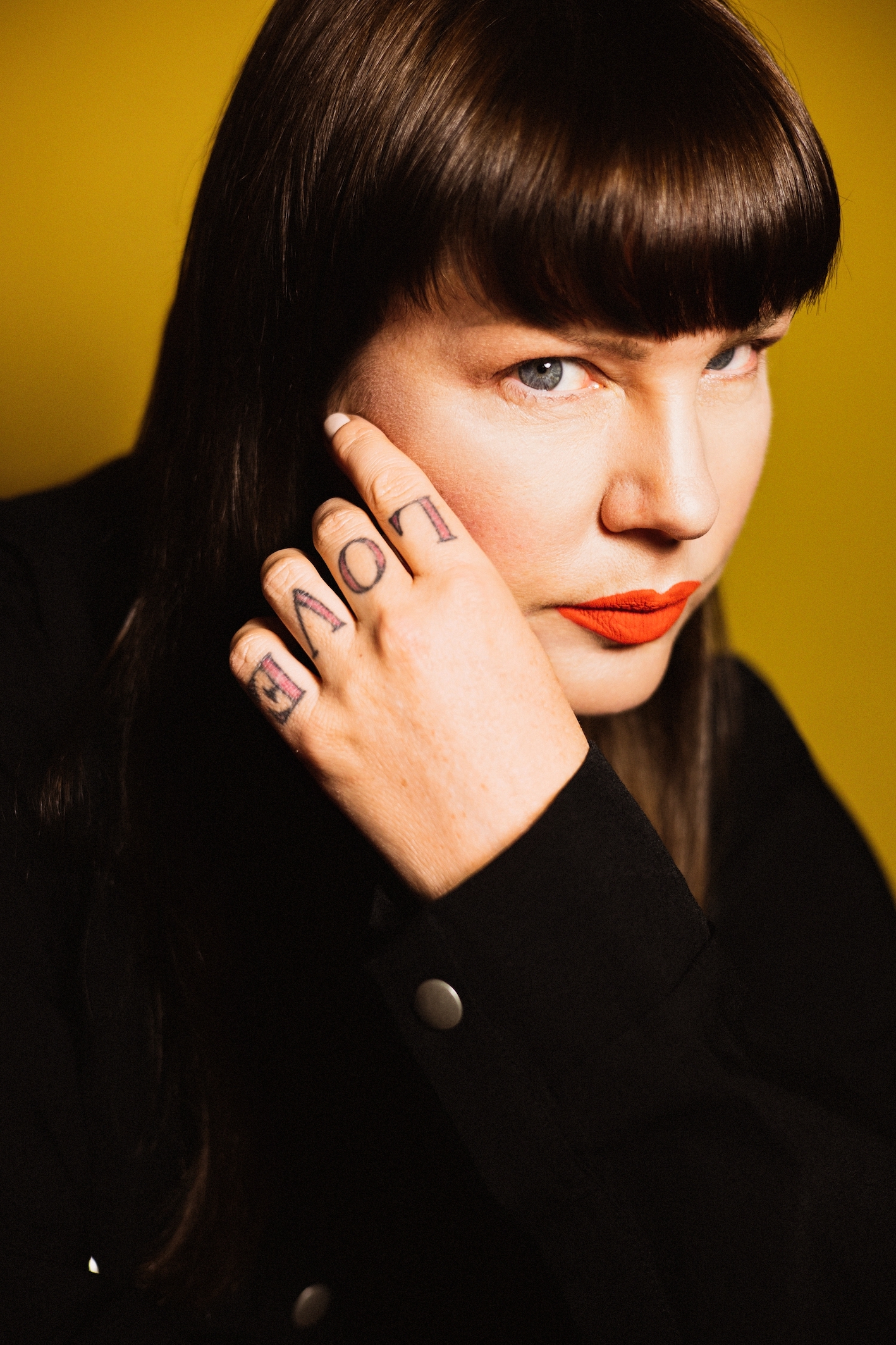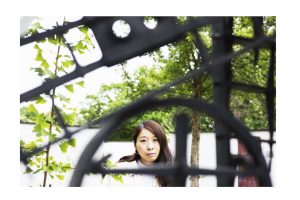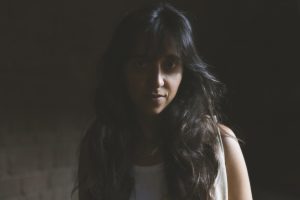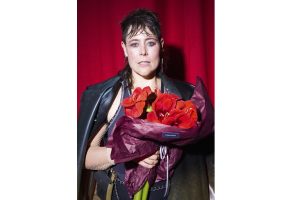Katja Ruge: “Every project I do is exciting for me, otherwise I wouldn’t do it”
Katja Ruge has been a well-known figure in the electronic music scene since the early 90s and for me she is the Annie Leibovitz of Germany. Her photography is like finely chiseled sculpture, always on the point, clear, unforgettable and my first photo session with her was so concentrated and yet relaxed that I was surprised at how quickly the time flew by.
There is hardly a musician, singer or band from the last thirty years that has not been portrayed by Katja and many of her photos are now legendary. Her rock star status may come from the fact that she also DJs, produces music and is a promoter, but I think it’s mainly because of her personality. Before I met her, she had already been recommended to me as a special dignitary by several artists. Her talent, instinct, straight forwardness and energy were highly praised, but also her loyalty and warmth of heart. These qualities are noticeable during her photo sessions and an unusual feeling of security and trust arises. I usually feel uncomfortable being photographed, but I had a lot of fun with her. Today, many artists speak about AI with concern, fearing that they will be replaced by machines. Katja is living proof of that the character of a person influences their work and the result is accordingly. This human touch cannot be replaced. I am very pleased to be able to discuss a few topics with Katja here today, even though she is, as always, very busy working with several commissions and productions simultaneously.
Danielle De Picciotto:What do you look for in photography?
Katja Ruge: I’m not looking for anything, I’m doing it. When I take portraits, I always look for connection, for alliances. Having fun together, exchanging ideas, making it easy for people to be photographed. Alfred Eisenstaedt said it very well:
“It is more important to click with people than to click the shutter.”
I don’t think about “expresstion”, it happens through what is described above.
Did you study photography? How did you start?
I can’t really pinpoint it, but my dad put me up with a friend in the photo lab in Hamburg because I was a bit lost and didn’t know what I wanted to do. The graphics school I did before hadn´t convinced me, but I loved working in the lab because it gave me a deeper understanding of photography, even before I started taking photos. Photography was part of the school’s training and that’s where it started. I took my first pictures right in front of the front door of concrete parts for the sewer system that were stacked on top of each other.
I’ve been clubbing in Hamburg ever since I was 17 and that’s how I made the first contacts that would later be groundbreaking for me. Through a friend, I started working regularly for a magazine and my boss at a photo agency at the time recognized my love for music and sent me to concerts with a camera. From then on I photographed concerts non-stop. This immersion in movement and music was the ultimate thrill for me. And of course I thought it was really cool to be in the front row. Its still the ultimate thrill for me today. I only really enjoy concerts when I can look at the musicians hands. Big concerts can be ok, but there’s something going on there that I don’t like, it often seems dehumanized. Björk can do carry it off, a few others too, but often it’s like in the car industry. Its only about who’s faster, louder, more colorful, bigger. I like the quiet parts in music. Or the silence before the explosion.
You worked for the magazine Groove for a long time.
What interested you there?
I love meeting people who make or DJ music, I usually feel a direct connection straight away. Music is magical and combining images with it is my addiction. It started with the goth magazine Zillo, then the Front Page, flyer and then actually Groove followed almost at the same time as the Intro and again later Missy magazine. And that’s just the music magazines. Magazine culture is now almost extinct. When I stand in the airport and look at magazines I always feel a bit wistful because it was always so nice to see my own pictures printed and many magazines no longer place orders at all but use stock material . The magazines are thin and full of advertising and they no longer feel as valuable. I used to have a picture published somewhere almost every week, over years and it made me happy. The magazines helped shape my photographic style. The quick, rushed appointments somewhere in hotels or concert venues were the ultimate rush for me. Even today. I love short and sweet sessions.
What were your most exciting projects?
Every project I do is exciting for me, otherwise I wouldn’t do it.
But they only last a certain time, and then they are finished and I move on.
The project that has touched me the most so far was my “Ladyflash” exhibition in Hamburg in 16/17. Exhibiting 100 of my female musician portraits in one room was overwhelming. With each musician a story emerges while taking photos and bringing them all out again was intense. The exhibition was also dedicated to my mother, who was already seriously ill with Alzheimer’s at the time and I am so happy that I was able to show her this exhibition and that she understood when I told her I wouldn’t have done any of this without you. That was very important for me. This exhibition also showed me how important it is for women to show other women who are making a difference and to be accessible to younger generations as an artist.
At the moment I am participating in an exhibition in Hamburg with Sheila Rock, Janette Beckman, Ilse Ruppert and Roberta Bayley, which seems almost unbelievable to me because the four of them are heroines of music photography. They come from a different time, mainly 70s/80s, but my work starts in the 90s/2000s so there is a kontinuum. DJ Koze, Helena Hauff, Phono from Hamburg link wonderfully to the Beastie Boys, Marc Almond and Peaches.
What do you think about AI?
: I can’t say much yet because I haven’t dealt with it honestly and intensively yet. I haven’t had time yet when so much is happening in real life. Since I’m more interested in people’s expressions, it may well be that I can’t do anything with it, unlike e.g. to my great colleague Sevda Albers, fashion photographer, who is currently developing her own fashion collections and creating worlds of images, which is brilliant. But she labels it specifically and explains in great detail what she does there. Then it’s real again and I like that. And it makes me curious.
Photography is always changing due to advancing technology and what is happening in the world. People can filter all that and turn it back into images. I can imagine AI for some areas of photography, but less so in my work. But maybe next week I’ll be proven wrong and re-think again.
Do you edit your photographs with Photoshop?
Or do you think a photo should be created through pure photographic art?
Pictures that I take continue to inspire me on the computer. There, through a crop or the intensification of color, a pattern and especially the portrait, the image you see later is created.
When you take digital photos, you first have a negative (raw) and something has to happen to it. Every photographer who takes digital photos manipulates their image. But there are big differences here, especially in the subjects you photograph.
In architecture, I might want straight lines, but If didn’t get as close as I wanted to when taking photos, due to the circumstances on site, then it’s straightened. I e.g. I often have annoying little things that don’t fit into the composition of the picture or simply don’t tell anything in the picture. Something like that is retouched away.
I also do facial retouching. If I take a portrait and the person says to me, ugh, I look really ragged today, or I don’t feel comfortable with the deep wrinkles there, then they are softened. I am always concerned with the well-being of the people I portray. The pictures are often sent to bookers etc. and no one wants to be seen with deep dark circles under the eyes, skin blemishes and the like. Why? To look authentic? The moment you are photographed, you are already filtered through me as a photographer. In my work, everything is always spoken about & agreed upon in detail with the person in front of the camera. Or the management.
Which photographers do you find most interesting today?
I’m a fangirl of Elizaveta Porodina (but that’s partly because I once received the sweetest message from her because she crashed at one of my parties; and I’ve been following her art ever since), Alexandra Polina from Hamburg and there are also a lot of favorite photographers in the Perspective Photographers collective, of which I am a member.
What are you currently working on?
“Electric Lights-Women in Electronic Music” is taking up a lot of time right now.
The best thing is that the project is now going live, there will be the first Electric Lights DJ Sets Night on October 11, 23 at the Planetarium in Hamburg. I am now inviting some of the musicians photographed to perform there. Starting off with Helena Hauff! I am looking forward to that. It’s been over 10 years since we met and met at the Golden Pudel Club and I’m really happy that we’re now doing this together.
There are other projects coming up, one of which is happening this year, but I can’t talk about it yet!
Musically, there are two releases coming up this fall, a remix for Cada Un, a post punk band from Kiel and a solo track for a compilation!
What are your plans for the future?
Enjoying every moment I live and work, the same goes for all the other things I do in life. Spending time with family, continuing to make music as “Can Love Be Synth” with Frank Husemann in the Synthesizer Studio Hamburg and DJing.
I had a heart ablation during Corona; a heart defect was discovered. I’m actually still recovering from the shock; it was a very pivotal moment in my life. Reset. I still don’t do many things the way I would like to, but I pay more attention to myself and am now much closer to myself, which also feels much better in my work.



















